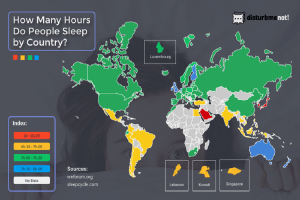Learn How to React: 90+ Allergy Statistics (Infographic)
written by / January 25, 2021
Allergies are among the most common chronic conditions in the world. Simply put, an allergic reaction occurs when our immune system confuses a harmless substance with an invader. Its overreaction to an allergen can result in a wide range of symptoms, from mild but annoying to life-threatening. Although allergies can’t be cured, there are numerous preventative and treatment measures.
So let’s dive into the world of allergy statistics. Among other things, you’ll learn what type of allergens exist, how many people suffer from allergies, and how deadly allergies can be. Prepare to be shocked!
The 10 Most Surprising Allergy Statistics to know in 2021
- Allergies affect over 50 million Americans every year.
- 54.6% of people in the US have had a reaction to at least one allergen.
- 10% to 30% of the world population suffers from allergic rhinitis.
- 32 million Americans suffer from food allergies, according to food allergy statistics.
- There are 200,000 visits to the emergency room every year due to food allergies.
- 90 to 100 Americans die every year due to anaphylaxis caused by insect stings.
- 24.6 million Americans have asthma.
- 2 million people visit an emergency room because of asthma every year.
- About 50% of study participants reported that allergies negatively affected their night’s sleep.
- Allergies incur an annual cost of over $18 billion for the US.
You can find much more stats in the infographic below.
Allergy Prevalence
Here, we’ll be looking at the prevalence of allergies in the United States as well as around the world.
1. Allergies affect over 50 million Americans every year.
(ACAAI)
According to the CDC’s allergy facts, allergies are the sixth leading cause of chronic illness in the US. Hay fever, asthma, and eczema are among the most prevalent allergic diseases.
2. 54.6% of people in the US have had a reaction to at least one allergen.
(Healthline)
The number of people suffering from allergies is on the rise, with hay fever being the most prevalent allergic disease.
3. Children whose parents suffer from allergies are more likely to develop an allergy.
(WebMD)
Based on allergy stats, if only one parent has an allergy, there’s a 30% to 50% chance their child will also be allergic. If both parents suffer from allergies, the risk that their child will develop an allergy is 60% to 80%.
Hay Fever Statistics
In this section, we’ll be focusing on hay fever as a specific set of allergies.
4. 10% to 30% of the world population suffers from allergic rhinitis.
(World Allergy Organization)
In addition, hay fever affects up to 40% of children in the world. Unfortunately, this number has been rising in the last few years, which may be a serious problem since allergic rhinitis can lead to asthma. According to the World Health Organization’s allergy statistics, this is a worldwide problem since there are 400 million people with hay fever and 300 million with asthma.
5. About 7.8% of US adults suffer from hay fever.
(CDC)
Hay fever doesn’t have anything to do with either hay or fever. This is a common name for allergic rhinitis, a condition caused by sensitivity to pollen, dust mites, pet hair or dander, or mold. Essentially, we are looking at pollen, pet, mold, or dust allergy statistics. Some of its symptoms include sneezing, stuffy or runny nose, itchy eyes, and fatigue.
6. Immunotherapy for hay fever is effective in 85% of the cases.
(ACAAI)
Allergic rhinitis can be seasonal and perennial. According to seasonal allergy statistics, from 1995 to 2015, the ragweed pollen season in the US increased from 1 to 3.5 weeks. Besides avoiding allergens, people with hay fever can consider allergy shots because immunotherapy can reduce the symptoms of allergic rhinitis.
7. In 2007, there were 13.4 million visits to the doctor with a primary diagnosis of hay fever.
(Healthline)
According to the WHO, allergic rhinitis is among the major chronic respiratory diseases in the world.
Food Allergy Statistics
Here, we’ll be exploring food allergies and looking at some statistics and facts that shed light on these types of allergies.
8. 32 million Americans suffer from food allergies.
(Food Allergy Research & Education)
This number also includes 5.6 million children who have food allergies. The following stat includes the most common food allergies.
9. 8 foods cause 90% of all food allergies.
(CDC, Food Allergy Research & Education)
These include milk, eggs, peanuts, tree nuts, soy, wheat, fish, and shellfish. Walnuts, almonds, and pistachios are just some types of tree nuts. However, over 170 foods have been associated with allergic reactions.
10. 2.8% of US adults are allergic to seafood.
(ResearchGate, FARE)
And based on peanut allergy statistics, 0.6%–1.3% of Americans are allergic to peanuts, which are also one of the most prevalent food allergies.
11. About a third of children with a food allergy are bullied.
(Food Allergy Research and Education)
Kids who suffer from a food allergy are twice as likely to be bullied as children without an allergy.
12. 8% of US children have a food allergy.
(American Academy of Allergy Asthma & Immunology)
According to a US study, about 38% of children suffering from a food allergy have had a severe reaction. Among kids, peanuts cause most food-based allergic reactions. They’re followed by milk and shellfish. Milk allergy statistics show that around 21% of children with food allergies are allergic to this type of food.
13. There are 200,000 visits to the emergency room every year due to food allergies.
(Asthma and Allergy Foundation of America)
Anaphylaxis is the major reason people with food allergies get hospitalized.
14. Teenagers and young adults are at a higher risk of fatal anaphylaxis than other age groups with food allergies.
(FARE)
In addition, asthma increases the risk of severe food allergy reactions. Interestingly, food allergy death statistics show that most fatal food allergy anaphylactic reactions occur when dining away from home.
Drug Allergies
It’s possible to be allergic to a specific drug. In this section, we’ll be looking at drug allergies.
15. About 10% of the world’s population may experience adverse drug reactions (ADR).
(World Allergy Organization)
The antibiotics most commonly associated with drug hypersensitivity reactions (DHR) include penicillins, cephalosporins, and sulfonamides.
16. About 20% of fatalities caused by anaphylaxis can be associated with DHR.
(World Allergy Organization)
Drug hypersensitivity reactions can affect various organs and range from mild to severe. According to allergy statistics worldwide up to 2021, 23%–35% of people claimed to have an antibiotic allergy.
17. About 10% of people are allergic to penicillin.
(American Academy of Allergy Asthma & Immunology)
However, most of them aren’t truly allergic to this antibiotic. What’s more, the majority of them will probably lose their allergy over time.
Insect Allergy Statistics
Here, we’ll be discussing allergies to insects and looking at stats and facts about this particular type of allergy.
18. 5% of people suffer from an insect allergy.
(ACAAI)
Although this allergy can’t be cured, venom immunotherapy is effective for preventing severe reactions to insect stings.
19. 90 to 100 Americans die every year due to anaphylaxis caused by insect stings.
(ACAAI)
According to the statistics related to an insect sting allergy, about 0.4% to 0.8% of children and 3% of adults experience life-threatening reactions because of insect stings.
20. About 50% of fatalities due to an insect allergy occur in people who haven’t had a previously documented systemic reaction.
(World Allergy Organization)
Wasps and hornets are among the species that most frequently cause anaphylaxis.
Latex Allergies
In this section, we’ll be focusing on latex allergies.
21. Between 1% and 6% of Americans have a latex allergy.
(Asthma and Allergy Foundation of America)
Health care workers are more likely to develop this type of allergy than other people. This is from the Asthma and Allergy Foundation of America and doesn’t take into account allergy statistics by country as it only focuses on the US.
Skin Allergies
Skin allergies can be caused by a number of things. In the following section, we’ll be discovering more about skin allergies.
22. About 13% of US children had skin allergies in 2017.
(CDC)
According to statistics from 2017, children aged 0–4 years are the most prone to skin allergies. If you look at skin allergy percentages today, you will likely find that they are similar.
Asthma
Asthma is an allergy that affects a large number of people around the world. We’ll be looking into this type of allergy in the following section.
23. 24.6 million Americans have asthma.
(ACAAI)
The airways of people who suffer from this chronic disease are always inflamed. In the case of allergic asthma, symptoms occur when allergens, such as dust mites, pollen, or mold, are inhaled. This is the most common type of asthma.
24. More children suffer from asthma than adults.
(WebMD)
Based on asthma statistics, 8.4% of children have asthma in the US, compared to 7.6% of US adults with this chronic disease.
25. 2 million people visit an emergency room because of asthma every year.
(WebMD)
In 2015, asthma caused 3,615 deaths in the US.
Sleep and Allergies
How do allergies affect sleep? Here, we’ll be exploring the relationship between sleep and allergies.
26. Hay fever has an adverse effect on sleep quality.
(NCBI)
According to a French study, the more severe a person’s allergic rhinitis is, the more impaired their sleep. Since nasal congestion is one of the symptoms of hay fever, allergies can increase the risk of snoring. Therefore, people with allergic rhinitis might benefit from using a snoring device. Although there’s a list of both the best and worst states for allergies, you don’t have to move just because of hay fever. Instead, make your bedroom allergy-free.
27. Hay fever increases the risk of obstructive sleep apnea syndrome in children.
(NCBI)
Since allergic rhinitis leads to a stuffy nose and enlarged tonsils and adenoids, it’s associated with an increased risk of developing OSAS. Therefore, it’s vital to treat hay fever appropriately to prevent sleep apnea or at least reduce its symptoms.
28. About 50% of study participants reported that allergies negatively affected their night’s sleep.
(WebMD)
They had problems falling asleep, and nasal congestion and other allergy symptoms woke them up during the night. Only 17% of them were satisfied with their sleep quality. Therefore, allergies can clearly lead to sleep deprivation, which may be prevented by appropriate allergy treatment.
Allergy-Related Costs
What are the direct and indirect costs associated with allergies?
29. Allergies incur an annual cost of over $18 billion for the US.
(ACAAI)
Besides direct medical costs, allergies can be associated with indirect costs, which are commonly caused by absenteeism, lowered productivity, and premature deaths.
30. Caring for a child with a food allergy is costly.
(Food Allergy Research and Education)
According to research, the overall costs for US families amount to $25 billion a year. Based on food allergy statistics worldwide, milk allergies were associated with the highest average cost compared to other food allergies. In addition to medical treatment and expensive allergy-free food, most parents often miss work or even have to give up work to care for their children.
Final Word
Allergies are a chronic condition that negatively affects all aspects of a patient’s life, including the quality of their night’s rest. Unfortunately, as the allergy statistics indicate, the incidence of allergies is on the rise. Every year, there are more and more people suffering from hay fever. Additionally, an increasing number of children develop food allergies that stick around for a longer period of time than they had in the past.
Although there’s no cure for allergies, there are a number of effective treatments that can alleviate the symptoms. However, more research should be done to find ways to prevent and treat allergies, which can sometimes even be life-threatening.





